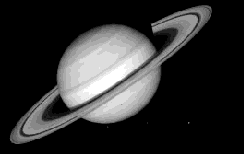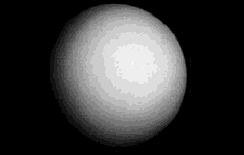
Voyager 2 took images of Saturn in 1981 from which this true-color image of the planet was assembled.
Saturn
Saturn, the sixth planet, is a giant, gaseous planet with an intriguing atmosphere. Alternate jet streams of east-west and west-east circulation can be traced in the motions of the cloud tops; the speeds of these jet streams reach as much as 625 km/hr, and are responsible for the banded appearance of the clouds. The atmosphere consists mostly of hydrogen and helium, but also includes trace amounts of other elements. Electrical processes and heat from internal planetary sources enrich the layered chemical mix of the atmosphere, which probably transitions from superheated water near the core to the ammonia ice clouds that are observed at the cloudtop. The planet's atmosphere also features storm structures similar to Jupiter's Great Red Spot. Saturn's magnetic field is 1,000 times stronger than Earth's.While Jupiter, Uranus, and Neptune also have ring systems, Saturn's ring system is the most extensive and brilliant. Today we know Saturn has 7 major ring divisions. The rings may be the remnants of moons destroyed by tidal interaction with Saturn's gravity. They may include remnants of comets that passed too close to Saturn and were likewise destroyed. Rings are composed mostly of ice crystals ranging in size from a few centimeters to a few meters. The major rings contain hundreds of ringlets, with some rings being "braided," others being flanked with small moons, and shadowy "spokes" developing and dissipating in the rings.
Of Saturn's 18 moons, some are covered in very smooth ice. Saturn's largest moon, Titan, is a little bigger than Mercury and has a thick atmosphere of nitrogen. This nitrogen atmosphere may be similar to primordial Earth, perhaps containing the chemical building blocks of life.

Uranus
First thought to be a comet, Uranus is the eighth planet from the Sun. Four times the size of Earth, Uranus' orbit extends 19 times farther from the Sun than Earth's orbit. Tipped, Uranus behaves as a giant top as it spins on an axis almost in the plane of orbit. This motion leads to extreme seasonal variation in what sunlight is available. Over the period of 1 Uranian year (84 Earth years), the polar regions of the planet go through four seasons, as on Earth, with perpetual sunlight in the summer, and total darkness in the winter. Periods of alternating day and night are interspersed in the spring and fall. Due to its great distance from the Sun, Uranus temperatures remain a somewhat constant -2200 C throughout the year.Uranus' atmosphere consists primarily of hydrogen and helium with a small amount of methane and other trace amounts of other gases present. The planet's bluish-green color is a result of the methane in the atmosphere absorbing red light. The planet's atmosphere is almost featureless with faint cloud markings between 200 and 500 south latitude. Wind speeds range from 100-600 km/hr and blow westward. At the equator winds were clocked at 1,042 km/hr, over four times faster than the strongest winds on Earth. Uranus has a magnetic field similar in strength to Earth's, but the magnetic field is tipped by about 50 degrees with respect to the axis of rotation.
Uranus possesses a system of at least 11 thin, widely separated rings. The rings of Uranus are optically dark, on the average reflecting only 2 percent of the sunlight that falls on them. Its 15 moons all lie along the planet's equatorial plane, tipped 98 degrees relative to the planets orbit to the Sun.